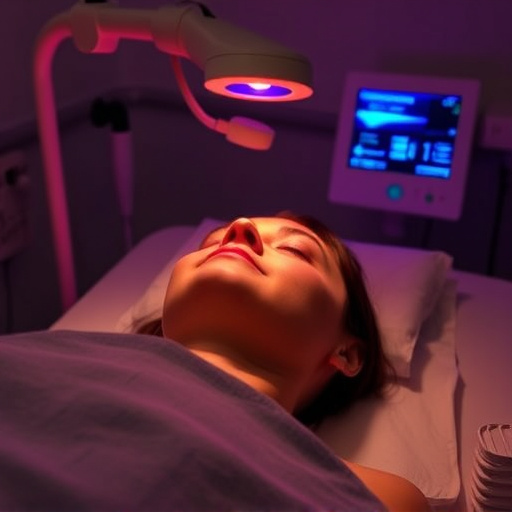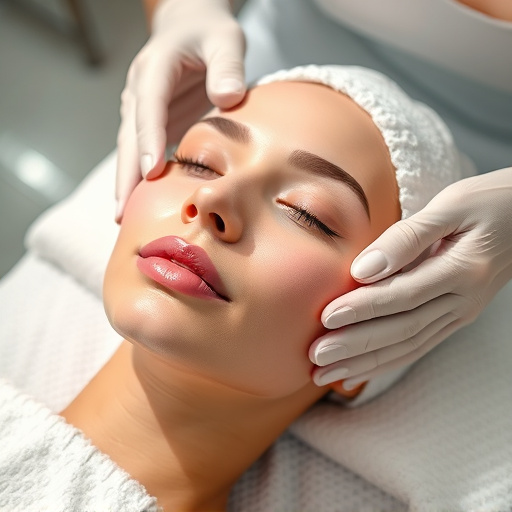Lactic acid peels, derived from natural alpha hydroxy acid (AHA), are a popular skincare treatment offering significant benefits for various skin concerns. They exfoliate dead skin cells, unclog pores, and reduce fine lines, hyperpigmentation, and acne. Lactic acid's hydrating properties make it ideal for dry or damaged skin, promoting collagen production and enhancing elasticity. Safe when performed by a licensed dermatologist, lactic acid peels are a gentle yet powerful tool, offering temporary side effects like redness or peeling, with minimal risks compared to stronger treatments like chemical peels or microneedling.
“Uncover the power of lactic acid peels as a potential solution for acne and dark spots. This comprehensive guide explores how these chemical exfoliants work their magic on your skin. We delve into the science behind lactic acid’s ability to reduce inflammation and fade hyperpigmentation.
While it offers promising results, understanding its safety profile is key. Learn about potential side effects and factors to consider before trying this popular skincare treatment.”
- Understanding Lactic Acid Peels: How Do They Work?
- Acne and Dark Spots: Are Lactic Acid Peels Effective?
- Safety, Side Effects, and Considerations for Lactic Acid Peels
Understanding Lactic Acid Peels: How Do They Work?

Lactic acid peels are a popular skincare treatment gaining traction for their potential benefits in addressing acne and dark spots. But what exactly are they? At its core, a lactic acid peel is a form of chemical peel that utilizes lactic acid, a natural alpha hydroxy acid (AHA) derived from lactose. This gentle yet potent exfoliant works by dissolving the bonds between dead skin cells, encouraging their shedding and revealing smoother, brighter skin underneath.
The process involves applying a concentrated solution of lactic acid to the skin, often with a brush or swab. Unlike harsher chemical peels, lactic acid peels are generally less irritating due to its milder composition. They can improve skin texture, reduce fine lines and wrinkles, stimulate collagen production, and even out skin tone. For acne-prone skin, these peels can help unclog pores and minimize the appearance of blemishes. Moreover, lactic acid’s hydrating properties can benefit dry or damaged skin, contributing to a more balanced and rejuvenated complexion. This makes it an appealing option for those seeking effective yet gentle skincare solutions, including those looking to enhance the overall appearance of their skin through treatments like microneedling therapy or exploring skin tightening techniques.
Acne and Dark Spots: Are Lactic Acid Peels Effective?

Acne and dark spots are common skin concerns that can impact self-confidence. Lactic acid peels have emerged as a popular and promising treatment option. These peels, derived from lactic acid, a natural alpha hydroxy acid (AHA), offer multiple benefits for achieving clearer, healthier-looking skin. By exfoliating the top layer of the skin, lactic acid peels help remove dead skin cells and unclog pores, which are often the root cause of acne. Additionally, its gentle yet effective nature makes it suitable for treating dark spots and hyperpigmentation, improving overall skin tone and texture.
Lactic acid is renowned for its hydrating and soothing properties, making it an excellent choice for individuals seeking anti-aging treatments without harsh side effects. Regular lactic acid peel sessions can stimulate collagen production, enhance skin elasticity, and promote a more youthful glow. Moreover, these peels are often recommended as part of comprehensive skincare routines to maintain optimal skin health and address various skin issues effectively.
Safety, Side Effects, and Considerations for Lactic Acid Peels

Lactic acid peels are generally considered safe when performed by a licensed dermatologist using proper techniques. They are a popular choice for treating acne and reducing the appearance of dark spots due to their ability to gently exfoliate the skin, unclog pores, and stimulate collagen production. However, as with any cosmetic procedure, there are potential side effects to be aware of. Some users may experience temporary redness, irritation, or peeling of the skin after a lactic acid peel treatment. These side effects usually subside within a few days.
When considering a lactic acid peel, it’s important to consult with a professional dermatologist who can assess your skin type and condition. They will determine the appropriate concentration of lactic acid for your needs and provide guidance on pre- and post-treatment care. Comparatively, chemical peels—which include higher concentrations of acids like glycolic or salicylic—may offer more significant results but also carry a higher risk of side effects, such as skin dryness, flaking, or in rare cases, hyperpigmentation if not performed correctly. Other procedures like microneedling therapy can also address acne scars and dark spots but involve different mechanisms and potential risks.
Lactic acid peels show promise in addressing both acne and dark spots, offering a non-invasive approach to skincare. By exfoliating the skin and stimulating collagen production, these peels can improve skin texture and tone. However, it’s crucial to understand their potential side effects and consult a dermatologist for personalized advice. If used correctly, lactic acid peels could be a game-changer in achieving clearer, brighter skin.














